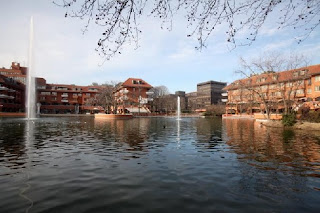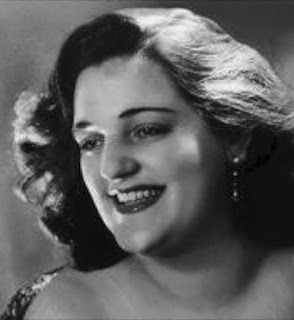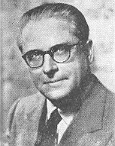Big-screen star who conquered television too
 |
| For many years, Raimondo Vianello was host of Sunday night sports show Pressing |
Vianello first rose to fame in the 1950s through a satirical TV show in which he starred with the great commedia all’Italiana actor Ugo Tognazzi, which was eventually banned.
From television he moved into movies, appearing in no fewer than 79 films in the space of just 21 years, between 1947 and 1968, some with Tognazzi, but also alongside other stars such as Totò and Virna Lisi.
His notable successes included his portrayal alongside Raffaella Carrà of a hopeless secret agent in Mariano Laurenti’s 1966 film Il vostro superagente Flit - a parody of Our Man Flint, an American production that was in itself a parody of the James Bond movies - and Michele Lupo’s comedy Sette volte sette (Seven Times Seven) in 1968, in which he portrayed an inmate in a London prison.
Vianello’s ban from television in 1954 followed a sketch on he and Tognazzi’s popular show Un due tre, broadcast by the Italian state network Rai, in which they sent up an incident at La Scala opera house in Milan the night before, when the Italian president Giovanni Gronchi suffered an unfortunate accident, lowering himself to sit in a chair next to the French president Charles de Gaulle without noticing the chair had been moved.
 |
| Vianello (left) with Ugo Tognazzi in a sketch from their 1950s satirical TV show Un due tre |
Together, they hosted a series of Saturday shows on Rai which made them an extremely popular couple.
The next time Vianello left Rai, it was of his own volition, lured away to work on the commercial networks, which had become major players with the involvement of entrepreneur and future prime minister Silvio Berlusconi.
Vianello and Mondaini fronted quiz shows such as Zig Zag and Il gioco del 9 on Canale 5, and for eight years Raimondo was the host of Pressing, a Sunday night sports talk show on Italia 1. He also hosted the 1998 edition of the Sanremo Music Festival alongside Eva Herzigová and Veronica Pivetti.
But it was his best-known and longest-lasting TV programme, Casa Vianello, a sitcom which aired from 1988 to 2008 in Canale 5 and later Rete 4 in which he and Mondaini performed as fictionalised versions of themselves, based on light and never-vulgar humour. It became a show beloved among Italians of all ages.
 |
| Vianello and his wife Sandra Mondaini presented many different shows together, including a long-running sitcom |
As a young man he joined Mussolini’s Italian Social Republic, the Fascist state established in northern Italy after the country’s surrender to the Allies in 1943. He served as a non-commissioned officer in the Bersaglieri corps. In 1945, he was captured by American troops and detained in the Coltano prison camp near Pisa.
After his long career, he died in 2010, a month short of what would have been his 88th birthday. His funeral took place at the in the Chiesa di Dio Padre in Milano Due, the new town within the Milan suburb of Segrate built by Berlusconi. After the funeral the body was transferred to Rome, to be buried in the family tomb at the Verano cemetery.
 |
| Pula's first century Colosseum is one of many Roman relics in the former Italian city in Istria |
Pula is a seafront city on the tip of Croatia’s Istrian Peninsula, known for its protected harbour, beach-lined coast and some of the most impressive Roman ruins outside Italy, including a first-century Roman amphitheatre, whose imposing outer walls are the best preserved after Rome’s Colosseum, and the Temple of Augustus. The Colosseum hosts the centrepiece of Pula’s annual calendar, the glitzy two-week film festival. The streets of Pula’s historic centre contain a historical jumble of Byzantine chapels, weather-beaten Venetian townhouses and grand Hapsburg palaces.
 |
| Waterways are a feature of the environment created at Silvio Berlusconi's Milano Due complex |
The town of Milano Due was the project that launched Silvio Berlusconi as a media magnate. Built by Berlusconi's construction company Edilnord in the 1970s, it is a residential centre close to the Segrate area of suburban Milan conceived by Berlusconi as a place for families to live in a safe environment, a system of walkways ensuring that its residents could reach any part of the community without encountering any vehicular traffic. The town features many parks and waterways and every house or apartment was connected to a cable television system run by another Berlusconi company, TeleMilano, Italy's first private television channel. TeleMilano was the project from which the tycoon would eventually grow his national TV company, Mediaset.
More reading:
How Ugo Tognazzi became a star of commedia all'Italiana
Virna Lisi, the screen siren who turned her back on glamour roles
Pippo Baudo, the TV presenter who became the record-breaking face of Sanremo
Also on this day:
1917: The birth of Sistine Chapel Choir director Domenico Bartolucci
1976: The birth of rugby star Andrea lo Cicero
1983: The birth of Olympic archery champion Marco Galiazzo
Home







